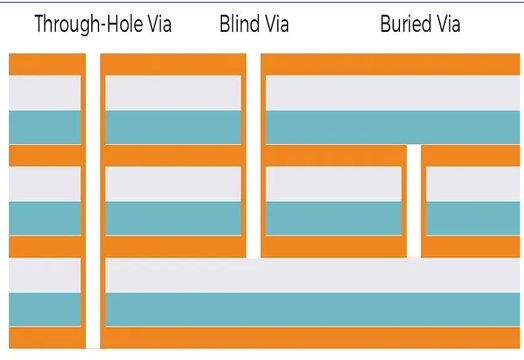The 3 Main Types of Flex PCB via
There are 3 main types of vias used in flex PCB manufacturing: through-hole via, blind via, and buried via. Each has its own advantages and challenges, and the choice impacts both production complexity and pricing.

1. Through-Hole Via
Through-hole via are the most common type. They pass through all layers of the printed circuit board, connecting the top and bottom, and sometimes multiple internal layers. This is a straightforward design that is cost-effective to produce, making it ideal for lower-cost applications. Flexible PCB manufacturers often use through-hole via for bulk production orders, keeping costs low.
However, through-hole via take up more space on the board, which can limit the potential for high-density designs. For applications requiring more complex, multi-layer flexible boards, blind or buried via might be a better choice.
2. Blind Via
Blind via only connect an outer layer to one or more internal layers, without passing through the entire board. This design optimizes space by allowing for higher routing density, which is critical for complex, multi-layer boards.
Blind via are more expensive to manufacture due to their complexity. However, the enhanced performance and space-saving benefits make them ideal for high-end devices like smartphones. If you're looking for a flexible PCB with compact design and better performance, blind via may be the right option despite their higher price.
3. Buried Via
Buried via are located entirely within the internal layers of the PCB and do not connect to the outer layers. This allows for even denser layouts and improved signal integrity in high-layer-count designs.
Buried via require a highly complex manufacturing process, which significantly increases costs. They're typically used in advanced applications, such as aerospace or military electronics, where performance is critical. If you're seeking best flexible PCBs, buried via offer the best reliability but come with a premium price.
Through-Hole vs Blind Via vs Buried Via: Which is Best?
In flexible PCB production, different via technologies influence manufacturing costs. More complex vias like blind and buried types take longer to produce and require higher precision, driving up costs.Each type of via has its strengths, depending on your project’s needs:
- Through-Hole Via: Best for low-cost, high-volume production; simple to manufacture and widely used for flexible PCB wholesale orders.
- Blind Via: Ideal for high-density designs; provides better performance but comes at a higher cost.
- Buried Via: Used for high-performance, multi-layer boards where signal integrity and space efficiency are critical; the most expensive option.
Choosing the right via type will impact both the performance and cost of your flexible PCB. Understanding these differences will help you make the best decision for your project.
How to Evaluate the Quality of Vias
Evaluating via quality is crucial for ensuring the performance and durability of a flexible PCB. Here are some key factors to consider:
1. Size and Consistency
Ensure the holes are of the correct size and consistently match the design specifications. Inconsistent sizes can cause signal transmission issues.
2. Plating Uniformity
The conductive plating on the hole walls must be even. Thin or uneven plating can lead to poor electrical connections or even failure.
3. Smoothness of Hole Walls
Rough or irregular surfaces inside the holes can disrupt signals or weaken the structure. A smooth finish ensures better signal transmission and mechanical strength.
4. Electrical Performance
Conduct tests to ensure the vias perform well electrically. Any issues with resistance or continuity may indicate poor quality.
5. Durability and Strength
The vias should withstand mechanical stress, especially in flexible boards. Testing for durability through bending or stress tests ensures that the vias won’t fail under pressure.
By following these guidelines, you can confidently assess the quality of vias in flexible PCBs and ensure they meet your project's needs.
In summary, FPC vias play a vital role in multi-layer circuit board design, ensuring that signals and currents between different layers can be transmitted efficiently and stably. Designing and manufacturing high-quality vias requires not only sophisticated engineering technology, but also a deep understanding of materials and strict quality control.
At I-tech Electronics Co.,Ltd ,We are able to build all above via holes on flex pcb and Rigid-flex pcb.
